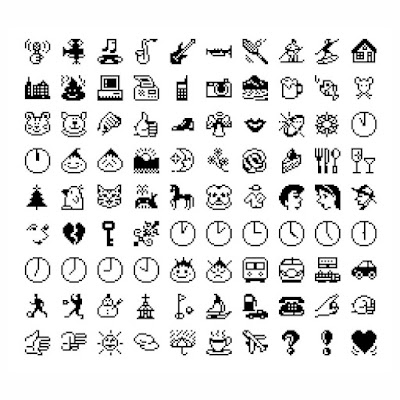 |
| The original JPhone emoji set (1997) |
As silly as it sounds, I decided I was not going to use emoji when I realised I didn’t know what any of them were supposed to mean. Their implementation as a keyboard on my phone, one that required me to select it over the regular English keyboard, made me think they act principally as pictograms, to use as word replacements – like a lexicon, but not like a rebus. Unable to find any kind of glossary, mainly because meanings applied to particular emoji are reached over time by consensus, rather than being prescribed, I decided I was better off not using anything that could cause confusion or misunderstanding – it is hard enough doing that using English words.
Mind you, I never used emoticons or Wingdings, both intended to add simple pictures to messages like adding a sticker, so I didn’t see the line that led to emoji. Wingdings was hampered by relying on both the sender and receiver having access to the same font, and emoticons were made less clear by having to be read on their side >:/ 8-> >:-( Analgoues to both systems are found in Japan, through kaomoji (“face character”, read in the same direction as text (ˊ•͈ ◡ •͈ˋ) ૮⸝⸝> ̫ <⸝⸝ ა), and in emoji (“picture character”, with no ties to emotion or emoticons).
With the latest Apple mobile system upgrade to iOS 15, I am now seeing emoji suggestions in their predictive text feature, and I cannot disable this feature, let alone the entire emoji keyboard. I know my mother only uses emoji other than a smiley face in text messages to me if they are suggested to her, like the fish that accompanied a mention of the McDonald’s Fillet-O-Fish. My biggest exposure to emoji has been on social media, where they are used to point, promote, and to clap between words to emphasise points being made. If I have ever used one at all, it may have been for effect, but it was too long ago for me to remember, and I can’t see any reason to start now.
Essentially, emoji began like Wingdings, as a proprietary font available only to users of a particular phone in 1997, the SkyWalker DP-211SW from JPhone, now SoftBank. A competitor, NTT DoCoMo, implemented their own emoji across their i-mode platform, beginning the mass usage that culminated in companies like Apple and Google supporting emoji in Japan first, and the need to attach emoji to Unicode, the international text standard, in order for the same images to be seen between different devices. This led to many pictures that existed in Unicode becoming emoji, including those previously added to the standard from Wingdings, Webdings and Zapf Dingbats.
New emoji are added yearly, and Unicode’s emoji proposal guidelines [https://unicode.org/emoji/proposals.html] are specific in what must be excluded, like logos, exact images, or having meanings that are transient or very specific – openness to interpretation and usage is built into the process. Therefore, when the “Melting Face” emoji was included in Unicode 14.0 and Emoji 14.0 from September 2021, people jumped on it as a symbol for our current times, a kind of sarcasm as things fall apart. Indeed, Jennifer Daniel and Neil Cohn, who conceived it two years before, intended it as a kind of embarrassment, a Western version of when Japanese manga characters turn into paper and float away. It sums up my inability to use such an established communication system perfectly.


No comments:
Post a Comment